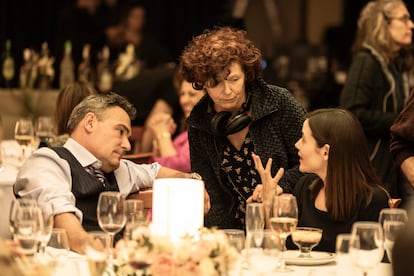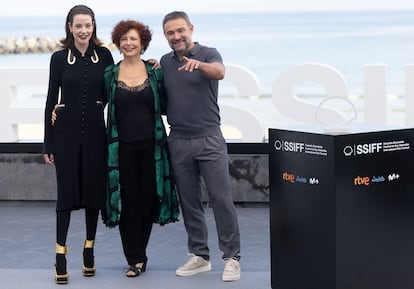“He was next to me. I couldn’t move.” That sentence, which economist Nevenka Fernández uttered in Valladolid at the High Court of Justice of Castilla y León during the trial against the mayor of Ponferrada, Ismael Álvarez, explains the paralysis that invades most victims of sexual harassment. A telluric fear that can be seen in other submissions, such as the woman sexually abused by members of the Manada in Pamplona, a terror that beats in the emotional heart of I’m Nevenka, by Icíar Bollaín, who is competing at the San Sebastián festival.
On paper, Bollaín and his co-writer, Isa Campo, and the producers, Juan Moreno and Koldo Zuazua, have repeated the scheme of Maixabel, his previous project: shooting in spring, launching at the San Sebastian festival, quick release in theaters (I am Nevenka (It hits theaters on Friday, the 27th). That, on the commercial side. But also in its soul: Maixabel y I am Nevenka They are about women who, at the time, few people wanted to understand, much less support. Both decided to face a vital disaster (one, the murder of her husband and the subsequent rapprochement with the ETA members who killed him; the other, the sexual and power abuse by her superior, a powerful mayor of a city where he also controlled the business circle, and his subsequent denunciation) as they believed they had to do, just against what society expected. And, therefore, they suffered silence and even many, too many, voices against them. I am Nevenka y Maixabel They can be seen as a diptych, which confronts the Spanish with their worst face, that of systemic machismo and the imperative social resource of “don’t make noise, don’t bother.”
I am Nevenka opts for a more didactic approach Maixabelprobably because even in 2024 many Spaniards (and not just men) do not understand sexual harassment or do not give it enough importance. Bollaín opts for a more conservative and classic direction in form, letting the confrontation between the main couple guide the narrative so that not one viewer leaves the journey. And when the ghost of ETA is most agitated, it should be remembered that Maixabel It was filmed in San Sebastian, while the producers of I am Nevenka They are still waiting for a response from Ponferrada City Council to film in the city: the exteriors have been shot in Zamora and the interiors, in Bilbao. By the way, Nevenka Fernández, who is in San Sebastian quietly accompanying the premiere, and Maixabel Lasa met this Saturday.
Bollaín and Campo begin in a leisurely manner. They introduce the prey, a 24-year-old girl with a brilliant professional future in Madrid who ends up attracted by an offer: to be part of the electoral list of the PP, a party that she and her family sympathize with, in her native Ponferrada. Fernández does not pay attention to certain signs about the mayor, Ismael Álvarez, and his influence over the women who make up his government team. After winning the elections, Fernández —who ended up disdainfully baptized as Nevenka, stolen from her surname and as an underline of a name that sounded foreign, to someone “who is from outside, not one of us”— became a councilor for Finance. And also, for a time, she maintained a romantic relationship with the mayor. Here the film stumbles: she was not attracted by a monster, but by Álvarez possessing a magnetism that deserves to be better shown on screen for the sake of the story and of understanding Fernández’s behavior. Because that relationship neither justifies nor invalidates subsequent events.

That instead, I am Nevenka illustrates with exemplarity. Mireia Oriol faces the descent into hell of a woman harassed by the mayor and overwhelmed by the image she must give to others. Oriol took advantage of her image of a certain moral ambiguity in the series Alma; Here she competes on another terrain and must endure a tough comparison: although for decades, the economist (a pioneer despite herself) was almost erased from the Spanish collective memory, the social changes of recent years, which have brought, for example, the law of only yes is yes, The recording of the press conference in which she announced that she had denounced her attacker has been resurrected from the archives. There we see a young woman devastated, who has already understood that her reconstruction will only happen through a legal battle. But, in addition, the documentary Calendula, by Maribel Sánchez-Maroto, released on Netflix in 2021, finally gave voice and image to the woman who achieved the first conviction for abuse against a politician in Spain. And that real Nevenka is so powerful in her restraint that Oriol can do little in her presence. To Urko Olazabal (Goya award winner for Maixabel) It was his turn to give life to Mayor Álvarez. Unlike his victim, the mayor talked a lot at the time, and then over the years he hid in Ponferrada. Olazabal knows how to handle the forcefulness of his physique, he is a textbook populist. His image is superimposed on that of the real Álvarez.
I am Nevenka It is important and necessary, but cinema cannot be built on the label of “a necessary film.” Fortunately, the film avoids this burden and flies towards its ending: it is a story of abuse, of a predator and a victim, and hopefully whoever sees it will have understood when the lights go on that a woman cannot move when her aggressor gets into her bed because she has no choice.

